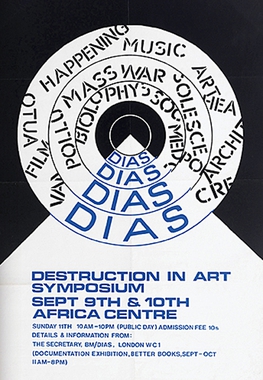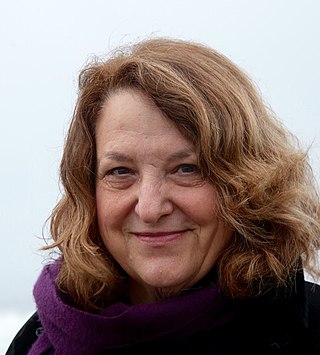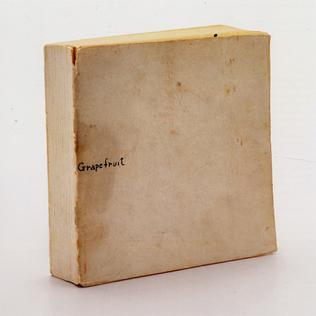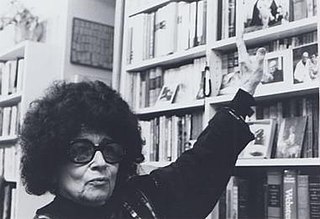
Fluxus was an international, interdisciplinary community of artists, composers, designers, and poets during the 1960s and 1970s who engaged in experimental art performances which emphasized the artistic process over the finished product. Fluxus is known for experimental contributions to different artistic media and disciplines and for generating new art forms. These art forms include intermedia, a term coined by Fluxus artist Dick Higgins; conceptual art, first developed by Henry Flynt, an artist contentiously associated with Fluxus; and video art, first pioneered by Nam June Paik and Wolf Vostell. Dutch gallerist and art critic Harry Ruhé describes Fluxus as "the most radical and experimental art movement of the sixties".

Performance art is an artwork or art exhibition created through actions executed by the artist or other participants. It may be witnessed live or through documentation, spontaneously developed or written, and is traditionally presented to a public in a fine art context in an interdisciplinary mode. Also known as artistic action, it has been developed through the years as a genre of its own in which art is presented live. It had an important and fundamental role in 20th century avant-garde art.

Gustav Metzger was a German artist and political activist who developed the concept of Auto-Destructive Art and the Art Strike. Together with John Sharkey, he initiated the Destruction in Art Symposium in 1966.
Madeline Charlotte Moorman was an American cellist, performance artist, and advocate for avant-garde music. Referred to as the "Jeanne d'Arc of new music", she was the founder of the Annual Avant Garde Festival of New York and a frequent collaborator with Korean American artist Nam June Paik.

Alfred Earl "Al" Hansen was an American artist. He was a member of Fluxus, a movement that originated on an artists' collective around George Maciunas.

Carolee Schneemann was an American visual experimental artist, known for her multi-media works on the body, narrative, sexuality and gender. She received a B.A. in poetry and philosophy from Bard College and a Master of Fine Arts from the University of Illinois. Originally a painter in the Abstract Expressionist tradition, Schneeman was uninterested in the masculine heroism of New York painters of the time and turned to performance-based work, primarily characterized by research into visual traditions, taboos, and the body of the individual in relation to social bodies. Although renowned for her work in performance and other media, Schneemann began her career as a painter, saying: "I'm a painter. I'm still a painter and I will die a painter. Everything that I have developed has to do with extending visual principles off the canvas." Her works have been shown at the Los Angeles Museum of Contemporary Art, the Museum of Modern Art in New York, the London National Film Theatre, and many other venues.

John Aubrey Clarendon Latham, was a Northern Rhodesian-born British conceptual artist.

Shigeko Kubota was a Japanese video artist, sculptor and avant-garde performance artist, who mostly lived in New York City. She was one of the first artists to adopt the portable video camera Sony Portapak in 1970, likening it to a "new paintbrush." Kubota is known for constructing sculptural installations with a strong DIY aesthetic, which include sculptures with embedded monitors playing her original videos. She was a key member and influence on Fluxus, the international group of avant-garde artists centered on George Maciunas, having been involved with the group since witnessing John Cage perform in Tokyo in 1962 and subsequently moving to New York in 1964. She was closely associated with George Brecht, Jackson Mac Low, John Cage, Joe Jones, Nam June Paik, and Ay-O, among other members of Fluxus. Kubota was deemed "Vice Chairman" of the Fluxus Organization by Maciunas.
Auto-destructive art (ADA) is a form of art invented by Gustav Metzger, an artist born in Bavaria who moved to Britain in 1939. Taking place after World War II, Metzger wanted to showcase the destruction created from the war through his artwork. This movement took place in England and was launched by Metzger in 1959. This term was invented in the early 1960s and put into circulation by his article "Machine, Auto-Creative and Auto-Destructive Art" in the summer 1962 issue of the journal Ark.

The Destruction in Art Symposium was a gathering of a diverse group of international artists, poets, and scientists to London from 9–12 September, 1966. Included in this number were representatives of Fluxus and other counter-cultural artistic undergrounds who were there to speak out on the theme of destruction in art.

Lynn Hershman Leeson is an American multimedia artist and filmmaker. Her work with technology and in media-based practices is credited with helping to legitimize digital art forms. Her interests include feminism, race, surveillance, and artificial intelligence and identity theft through algorithms and data tracking.
Raphael Montañez Ortiz is an American artist, educator, and founder of El Museo del Barrio, in East Harlem, New York City.

Dan Perjovschi is an artist, writer and cartoonist born on 29 October 1961 in Sibiu, Romania.

Robin Page was a British painter. He was one of the early members of the Fluxus art movement.

Grapefruit is an artist's book written by Yoko Ono, originally published in 1964. It has become famous as an early example of conceptual art, containing a series of "event scores" that replace the physical work of art – the traditional stock-in-trade of artists – with instructions that an individual may, or may not, wish to enact.
Grapefruit is one of the monuments of conceptual art of the early 1960s. She has a lyrical, poetic dimension that sets her apart from the other conceptual artists. Her approach to art was only made acceptable when [people] like Kosuth and Weiner came in and did virtually the same thing as Yoko, but made them respectable and collectible.

Spice Chess is an artist's multiple by the Japanese artist Takako Saito, while she was resident in the United States. Originally manufactured winter 1964–65, and offered for sale March 1965, the work is one of a famous series of disrupted chess sets referred to as Fluxchess or Flux Chess, made for George Maciunas' Fluxshop at his Canal Street loft, SoHo, New York City and later through his Fluxus Mail-Order Warehouse.
"Takako Saito engaged with Duchamp's practice but also with masculinist cold war metaphors by taking up chess as a subject of [her] art. Saito's fluxchess works... question the primacy of vision to chess, along with notions of perception and in aesthetic experience more generally.... Her "Smell Chess," "Sound Chess" and "Weight Chess" reworked the game of chess so that players would be forced to hone non-visual perception, such as the olfactory sense, tactility, and aurality, in order to follow chess rules." Claudia Mesch

DuBois-Deyo House is a historic home located at Rosendale in Ulster County, New York. It was built about 1750 and is composed of two sections. The main block is a two-story, four-by-two-bay stone and frame building with a two-story frame rear wing. Also on the property is a garage dated to about 1890.
The feminist art movement refers to the efforts and accomplishments of feminists internationally to produce art that reflects women's lives and experiences, as well as to change the foundation for the production and perception of contemporary art. It also seeks to bring more visibility to women within art history and art practice. The movement challenges the traditional hierarchy of arts over crafts, which views hard sculpture and painting as superior to the narrowly perceived 'women's work' of arts and crafts such as weaving, sewing, quilting and ceramics. Women artists have overturned the traditional view by, for example, using unconventional materials in soft sculptures, new techniques such as stuffing, hanging and draping, and for new purposes such as telling stories of their own life experiences. The objectives of the feminist art movement are thus to deconstruct the traditional hierarchies, represent women more fairly and to give more meaning to art. It helps construct a role for those who wish to challenge the mainstream narrative of the art world. Corresponding with general developments within feminism, and often including such self-organizing tactics as the consciousness-raising group, the movement began in the 1960s and flourished throughout the 1970s as an outgrowth of the so-called second wave of feminism. It has been called "the most influential international movement of any during the postwar period."

Lil Picard, born Lilli Elisabeth Benedick, was a cabaret actress, artist, journalist and critic, born in Landau, Germany, who took part in several generations of counterculture and avant-garde art in Berlin and in New York City.

Sabine Breitwieser is an Austrian curator, art manager and publicist.
















